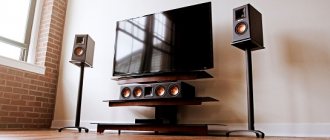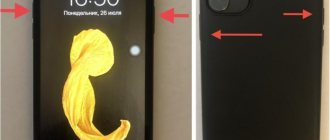In this article, I will show you some simple ways to quickly find out if your TV has Wi-Fi. Today, there are practically no TVs on sale with Smart TV and without a built-in Wi-Fi module.
I looked and found only a few models. This means that after some time, every smart TV will have built-in Wi-Fi. And it is right. And then they came up with these branded, external USB Wi-Fi adapters, which had to be bought for a lot of money, and even it was difficult to buy them. And now you can’t find them at all. But a TV is not bought for a year or two. Many people now have Smart TVs without built-in Wi-Fi. And you can connect them to the Internet only using a cable.
First you need to understand that if the TV does not have a Smart TV, then it definitely does not have Wi-Fi. In this case, it is not needed there at all. I have already written a separate article on this topic: Smart TV function on TV: is it there or not, how to check? But if there is support for Smart TV, then it is not a fact that there is Wi-Fi. There may be an option that the connection to the Internet is carried out only using a cable, or through an external Wi-Fi receiver (which most often needs to be purchased separately).
If you are wondering whether your TV has Wi-Fi or not, then you can find out in several ways:
- View TV specifications. The best place is on the official website.
- Check your TV settings.
- Look at the information on the box and in the instructions.
Let's look at the first two methods in more detail. The solutions are universal, suitable for all TVs: Samsung, LG, Sony, Toshiba, Philips, Panasonic, Hisense, TCL, Kivi, Ergo, etc. As for Xiaomi TVs, all models from this manufacturer have built-in Wi-Fi.
What is built-in Wi-Fi on a TV?
Previously, connecting a TV to the Internet was possible on many LCD models, but this required running a cable from the modem. This method of connection was not entirely convenient, especially since the stretched wires did not add beauty to the interior of the room. As a result, Smart TVs with Wi-Fi connectivity appeared. The essence of the technology is that a special adapter and a mini-computer are built into the smart TV. That is, along with a TV tuner, the user receives a computer capable of processing streaming video from the Internet and allowing you to visit certain sites.
Modern models of such TVs provide the ability to make audio and video calls in popular instant messengers, provided they have a microphone and a webcam. You can buy a TV with the Internet and Wi-Fi in an online store of household appliances and electronics with delivery by mail. Before ordering such a device, check out the types of Smart TV with wireless Internet:
- Model with built-in adapter. Connects to the Internet without any wires. Such a TV is capable of receiving a signal from the router on its own; you just need to enter your login and password correctly.
- A device with an external wireless communication module. In this case, the TV cannot independently pick up the wireless signal, so you need to connect an external adapter to it. This module is purchased separately and inserted into the USB port that the TV is equipped with.
Connecting with a network cable
The TV should have a LAN (RJ-45), it looks something like this:
If your TV only has such a LAN connector, then you can most likely connect it to the Internet only using a network cable (you may also be able to connect via the built-in Wi-Fi, or using a special, external Wi-Fi receiver, read below).
To connect using a cable, you can use a network cable, which you most likely have in your apartment (from your provider). But as a rule, such a cable is connected to a computer. In this case, it is best to install and configure the router. You connect the Internet to the router, and from it there is a cable to the computer, TV and other devices.
This is interesting: Error: “Insufficient memory” on LG Smart TVs when watching videos through the built-in browser
Plus, the router will distribute the Internet via Wi-Fi. You will be able to connect your devices (which have this capability) to the wireless network. Here, for example, installation and configuration of the TP-Link TL-WR841N router.
The disadvantage of this connection scheme is that you need to lay cables, and this is not always convenient and does not always work out.
How to choose a TV with Internet and Wi-Fi
The range of TVs with Smart TV and wireless Internet support today is huge. To avoid making a mistake with your purchase, consider the main selection criteria:
- First, make sure that the selected model connects to Wi-Fi. At the same time, check whether the device has a built-in module or whether you will have to purchase an external adapter separately.
- Screen diagonal. Modern TV models have diagonals from 14 to 105 inches. The range 32–55'' is in greatest demand. In order not to make a mistake with your choice, take into account the distance to the viewing area - the device is usually installed at a distance of 3 diagonals. Also take into account the area of the room (for the kitchen there is no point in buying a model with a large screen) and the intended purpose.
- Backlight type. One common option is Edge LED, which provides good viewing angles but (local) color dimming is difficult to achieve. Direct LED has no problems with this - such backlight covers more color shades and provides better dynamic contrast. Expensive models are equipped with QLED and OLED, which are the most modern.
- Permission. New models of recent years have 1920x1080 and 3840x2160 pixels. The higher the resolution, the clearer the picture will be. If you are going to watch only analog TV, then there is no point in choosing a device with FHD (1920x1080).
- Sound quality. The sound from the built-in speakers should be as clear and as voluminous as possible for comfortable watching movies.
- Response time, update rate. The first parameter refers to the time it takes for the crystal to change its position in one pixel. This determines how quickly the picture will change during a dynamic scene. The refresh rate should be as high as possible. Inexpensive models have no more than 100 Hz, mid-price models - 200-400 Hz, the most expensive ones - up to 1000 Hz.
- Interfaces. Jacks for connecting headphones, a webcam, a tuner, etc. A modern television receiver should have HDMI, USB, PAL, SCART and some other connectors, depending on the intended use of the device.
Connecting your TV using built-in Wi-Fi
This is already more interesting and much more convenient. If your TV model has built-in Wi-Fi, then you can connect to the Internet without any wires. The only thing is that you must have a router that will actually distribute this Wi-Fi. Well, or the neighbors already have it, without a password :).
Just be sure to check the specifications to see if the TV has the ability to connect to Wi-Fi. Better yet, ask managers (if you buy in an online store) or consultants.
Very often, they write that there is Wi-Fi support, but in fact there is no built-in receiver. It is only possible to connect an external receiver, which must be purchased separately (more on this below). Please check when purchasing!
Using a special external Wi-Fi receiver
If your TV does not have a built-in wireless receiver, but only a LAN network connector, but you cannot or do not want to lay a cable, then all is not lost. It may be possible to connect an external receiver to your TV model. Such a receiver is usually connected to a USB connector.
But you need to buy such a receiver separately. And they are not cheap. The trick is that you can only use a proprietary Wi-Fi receiver. For example, for Samsung such a receiver costs approximately 350 UAH. (1400 rubles). People know how to make money :), Just look at how much branded WEB cameras cost there. Other manufacturers are not cheaper.
But, if you have already decided to buy such a receiver, then be sure to check whether your TV model will work with it. You can call the support of the manufacturer of your TV and ask, they are definitely in the know.
It looks something like this:
This is interesting: What to do if the computer does not see the router via the network cable?
But there is another option, I’ll tell you: in order not to buy this expensive receiver, we buy some kind of cheap Wi-Fi router (yes, another one), for example TP-LINK TL-WR740N (costs about 150 UAH (600 rubles)) .
We place this router near the TV and connect it to the TV using a network cable. Then we configure bridge mode (WDS) on this router. More details on how to do this are written here.
What we get: this router, which we installed near the TV, receives the Internet via Wi-Fi from your main router (which, for example, is installed in the hallway) and distributes it via cable to the TV. And it also strengthens the Wi-Fi signal. Everyone is happy, everything works :). Perhaps later I will write in more detail how to do this, with pictures, etc.
The TV may have both a LAN connector and a built-in Wi-Fi module - then you can connect it as you wish.
Solution #1: check the presence of Wi-Fi in the technical specifications of the TV
All we need is to know the manufacturer and model of the TV, and access to the Internet. With the second one, I think there are no problems. Well, the TV model can be found on the box, in the documentation, and on the sticker on the back of the TV.
Then simply enter the manufacturer’s name and model in the Google or Yandex search engine. For example, I have a Philips 43PUS7150/12. It is advisable to go to the official website of the manufacturer.
Or open several popular online stores and look at the technical specifications. As a rule, the availability of Wi-Fi is always indicated there. I recommend looking at the specifications on the official website. In my case, in the “Connections” section, opposite “Wireless connection”, support for the built-in Wi-Fi 11n 2×2 module is indicated.
So there is Wi-Fi on my TV. It’s just not entirely clear why it says “Dual-band”. This TV does not support 5 GHz Wi-Fi. Only 2.4 GHz. If the specifications indicate support for the 802.11ac standard, then the TV supports the 5 GHz band.
You may find it useful: why Smart TV does not see Wi-Fi in the 5 GHz range.
If, as a result of the check, it turns out that your TV does not support Wi-Fi connection, and you need to connect it to the Internet via a wireless network, then read this article: how to connect a TV without Wi-Fi to the Internet via Wi-Fi.
Using the example of an LG TV
Let's take the LG 43UM7100PLB model. We find this model on the official LG website and look at the technical characteristics (specifications). If there is a dot next to “Wi-Fi support”, it means there is support.
If “-” means no. It may also be written: “When connecting a WiFi adapter (AN-WF500)”, “Optional”, “(Support)”. This means that you need to buy and connect an external USB Wi-Fi module (receiver). Only after this the wireless connection will work on the TV.
If there is no information about Wi-Fi at all, it means your TV model does not support a wireless network.
Samsung
In the same way, everything can be checked on the Samsung website. We take a model, for example, UE50NU7002UXUA and find a page with its characteristics on the Samsung website. “Built-in wireless network support” – “Yes”!
All this can be repeated with a TV from any manufacturer and any model. If there is no information on the official website, or you cannot understand something, look at other sites. It is advisable to look at several sites, as mistakes are often made there. I usually also look in the descriptions of popular online stores and in reviews.
Advantages and disadvantages of Wi-Fi on TVs
Built-in Wi-Fi on a TV has strengths and weaknesses. To understand whether it is worth overpaying for this feature, you need to carefully study and then compare the advantages and disadvantages of such TVs. Let's start with the positive qualities:
- easy synchronization with smartphones, laptops and other equipment;
- the ability to play multimedia content online;
- using a TV for demonstrations and presentations;
- launching video games, as well as various applications from the company store;
- Internet surfing;
- no wires.
The availability of a wireless Internet connection will significantly expand the functionality of the equipment. Cable Internet significantly limits the user. For example, if you decide to rearrange the room, you will not be able to change the position of the TV. In addition, the cable will always get tangled underfoot.
You can connect a webcam to modern Smart TVs for comfortable communication via Skype on the big screen. You can also connect a joystick to play video games. Even a regular smartphone can be an excellent alternative to a joystick.
Not everyone uses a TV with built-in Wi-Fi, since this technology has certain disadvantages:
- significant difference in price compared to conventional models;
- Internet speed is noticeably inferior to a cable connection;
- Additional equipment is required - a router.
There is only one serious drawback - the financial aspect.











